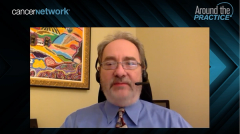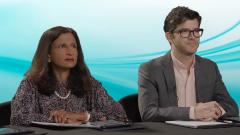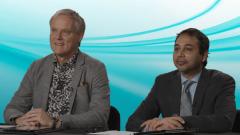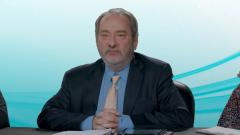
Clinical Trials in Transplant-Ineligible NDMM
Expert panelists review clinical data from studies investigating treatment regimens for patients with NDMM that are transplant-ineligible.
Episodes in this series

Transcript:
Robert Z. Orlowski, MD: Briefly if you don’t mind, there was an update of the MAIA trial at this meeting. The numbers look good, progression-free survival of 62 months vs 34 months. The overall survival [OS] for the Rd [lenalidomide and dexamethasone] group was 65.5 months, which thinking back years ago itself was pretty positive. But the median OS for the daratumumab-Rd group had not been reached, even though it’s been many years since the MAIA study has been ongoing. And the MRD [minimal residual disease] negativity rate was triple with the DRd [daratumumab, lenalidomide, dexamethasone] compared to the Rd.
Cesar Rodriguez, MD: It does seem like daratumumab is becoming a good player for upfront therapy, especially in transplant-ineligible [patients] because we know we’re not going to have that extra boost we get with the transplant. Then from that we also have the ALCYONE study, which is daratumumab with bortezomib, melphalan, and prednisone. This is a regimen that is not used as much here in the United States because we’re not used to doing melphalan, but it’s another option that is available there. But the big ones that have been adopted the most for transplant ineligible are the MAIA regimen, which is daratumumab, lenalidomide, dexamethasone, and the bortezomib, lenalidomide, dexamethasone, the VRd or VRd-lite, where we do the bortezomib on a weekly basis.
Amrita Krishnan, MD: Another interesting thing that came out from this meeting was the IFM study omitting dexamethasone though, right? That’s probably the most challenging drug for our patients. So using dexamethasone only for the first couple cycles of induction, then dropping the dexamethasone and doing daratumumab, lenalidomide vs the lenalidomide, dexamethasone. That doesn’t sound exciting compared to the CAR [chimeric antigen receptor] T-cell therapy and the bispecifics, but in terms of practice changing and quality of life for patients, that’s an important study.
Cesar Rodriguez, MD: You’re right…the presentation of taking frail patients and removing dexamethasone, and comparing it with lenalidomide and dexamethasone vs daratumumab and lenalidomide, showing how we can eliminate the dexamethasone in the regimens early. That could potentially be something we can start incorporating in other regimens, and it’s going to change our paradigm as to having to have a steroid in all of our regimens in myeloma.
Robert Z. Orlowski, MD: Ola, what’s your thought? You heard about VRd-lite and also about DRd. Do you use one or the other? Do you triage patients somehow between the 2? What are your preferences?
C. Ola Landgren, MD: There is not yet a study comparing these 2 regimens. They have all been done in comparison to Rd, and they always win. If you have VRd vs Rd, or DRd vs RD, you win. But the 2 head-to-head has not been conducted and published, so you’re back to the discussion we had before. We practice in different ways, what we believe in, and what we think is the right thing to help our patients. In my practice over time I use more and more DRd, and that’s what I see for all the referring physicians. That’s the practice in the geography where I am, in Miami, [Florida]. When I talk to other friends of ours across the country, and we’ll see what the rest of the panel here says today, but I hear that more and more groups are doing DRd. But there are some patients who maybe more aggressive disease.
Then the question comes up, do you have to choose between the 2? Why could you not do a quadruplet for that group as well? You could do daratumumab-RVd [lenalidomide, bortezomib, dexamethasone], or you could do daratumumab-KRd [carfilzomib, lenalidomide, dexamethasone]. Now in the nontransplant candidate population, there are more frail patients. Daratumumab-KRd, in my clinical experience, is less of a good option for many patients. That being said, you could have a healthy 76-year-old who is in good shape who could do extremely well with daratumumab-KRd. But on average, that combination can cause more trouble. You have to be careful which patient you give it to. I always do an echocardiogram, an EKG, and I check, and I’m careful with fluid. But I’m bringing up the argument, you have to choose. Sometimes you can bundle. But DRd is my default, and sometimes I add a fourth drug for those patients.
Amrita Krishnan, MD: Can I put another plug in for SWOG?
Robert Z. Orlowski, MD: Go for it. I was going to, but no, please go ahead.
Amrita Krishnan, MD: There you go. SWOG is doing that randomized study, and it’s Brea Lipe, [MD,] who’s leading it, of DRd vs RVd-lite. That’s an exciting study.
C. Ola Landgren, MD: Those are the data we need to see.
Robert Z. Orlowski, MD: It’s a 3-arm study, so there’s VRd-lite induction, followed by R [lenalidomide] maintenance. There’s DRd followed by R. And then there’s DRd followed by DR maintenance. So it may take a few years, but hopefully all of you will participate and help us to answer this question.
Transcript edited for clarity.
Newsletter
Stay up to date on recent advances in the multidisciplinary approach to cancer.























































































